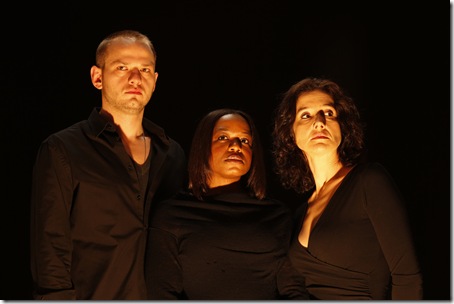Neva: A Confluence of Theatre and Revolution
Photo. Carole Rosegg.
Neva, Guillermo Calderón’s tribute to Anton Chekhov, takes place in a theatre in Saint Petersburg on January 22, 1905, known to Russian history as Bloody Sunday, the catalyst for the Revolution of 1905. On that day, striking workers marched to the Tsar’s palace to present a petition and were fired upon by armed guards. Thousands died. The title refers to the river which runs through Saint Petersburg, the site of numerous violent historical events, including Bloody Sunday. Theatre and revolution are the focus of the play.
Chekhov’s widow, Olga Knipper (Bianca Amato) has come from Moscow to rehearse her husband’s The Cherry Orchard. But apart from a monologue that she gives at the play’s opening, the rehearsal never transpires. Only two other actors are present, Masha (Quincy Tyler Bernstine) and Aleko (Luke Robertson), both eager to impress the celebrated Knipper. Anxious about her career, Knipper feels as if her talent and ability to experience emotion in life have died along with her husband. Self-absorbed, she is unmindful of the events taking place in the streets of Saint Petersburg. From time to time those events are made manifest through the sounds of shooting.
Ostensibly, as a means of helping restore her emotions, Masha and Aleko improvise scenes from Knipper and Chekhov’s lives, most notably the playwright’s death in Germany six months earlier. The scenes allude to Chekhov’s plays and interweave his dialogue at moments. Knipper, as critic, director, and teacher, is particularly harsh with Masha, sometimes poking fun at her. Like her maître Stanislavsky, Knipper is searching for theatrical truth.
The interactions between the actors in the darkened theatre relate to the revolution outside. In the guise of acting, Aleko and Masha revolt against Knipper, who is at the top of their theatrical hierarchy. In one of his improvisations, Aleko boorishly attempts seduce her. Masha, as Chekhov’s sister, insults Knipper as unfit to be her brother’s wife. As in Chekhov’s plays, painful situations are leavened with humor.
At Boston’s Paramount Center’s Black Box theatre, the entire play is performed on a square platform about three feet high and approximately eight feet long per side. The minimal set consists of an armchair and a diagonally placed scarlet rug, the only bright color in the production. As a symbol, it is a little heavy handed, suggesting blood and the eventual triumph of the Bolsheviks in 1917. Much of the platform is shrouded in black, including the background hangings. The actors are dressed in black and brown. It is a claustrophobic and threatening atmosphere, reminiscent of Jean-Paul Sartre’s No Exit and Beckettian drama. The metaphorical space confines the actors’ movement, placing the emphasis on the oftentimes poetic words, which are spoken with passion and speed. An anachronistic rectangular space heater down front is the only source of light; it shines upward illuminating the actors’ faces. Likely, the anachronism is meant to remind the audience of contemporary struggles for justice. As Calderón has explained in interviews, his own experience of growing up under the violent and repressive Augusto Pinochet regime underlies much of his writing.
Neva works on at least a twofold metatheatrical level. In one sense, it is a play containing four plays. While Neva, like The Cherry Orchard, is a drama in which Russia is on the brink of enormous social change, The Seagull, Uncle Vanya, and Three Sisters also make an appearance. Masha and Olga Knipper have a Nina and Madame Arkadina relationship; Knipper is Yelena to Masha’s Sonya; and Aleko wants to go to Moscow. On another plane, it questions the meaning, place, and role of the theatre in a chaotic world.
The play is beautifully acted with Bianca Amato’s arresting performance as the hyperbolic and needy star. Quincy Tyler Bernstine effectively transitions from adoring admirer to revolutionary in a final monologue in which she decries the bourgeois theatre and its audiences before taking off to join the striking workers in their struggle against the tsarist troops. Luke Robertson is convincing as Aleko, an aristocrat turned actor, whose Tolstoyan beliefs are in opposition to his improvised characters.
Guillermo Calderón capably directed his own play in an English translation by Andrea Thome. Neva is the first of his six plays to be translated. His works have toured the Americas and Europe, garnering praise. In 2009, Calderón’s troupe brought the Chilean Neva to Montreal’s Festival Transamériques. This new production has enriched the Boston season. Calderón is a playwright to be followed.
Written and Directed by Guillermo Calderón
Translated by Andrea Thome
Costumes Designed by Susan Hilferty
Lighting Designed by Russell H. Champa
Music by Tomás Gonzales
Cast
Olga Knipper – Bianca Amato
Masha – Quincy Tyler Bernstine
Aleko – Luke Robertson
April 3 to 7, 2013
